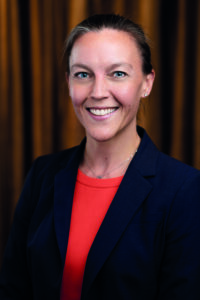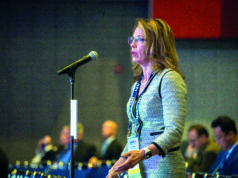
For surgeons, “EPA” means not the “Environmental Protection Agency” but “Entrustable Professional Activity”—and they’re going to change surgery training. A pilot rollout for vascular surgeons will begin in select centers in the fall with Vascular Surgery Board (VSB) implementation expected to begin in July 2024.
The American Board of Surgery (ABS) announced the move to competency-based assessment of surgical trainees in February 2022, introducing the ABS EPA Project. The project for general surgery residency programs, for instance, is set to launch in July.
It’s a slightly different version of the Norwegian concept of “entrustment” as a “core way of thinking about when a healthcare professional is ready to be unsupervised,” Brigitte Smith, MD, tells Vascular Specialist.
Smith, associate professor of vascular surgery and program director for the vascular surgery fellowship at the University of Utah in Salt Lake City, is leading work to develop the concept of an EPA program for the Association of Program Directors in Vascular Surgery (APDVS). APDVS directors reviewed the program and discussed pilot site recruitment at the APDVS Spring Meeting in March.
Smith said supervisors generally assess performance in terms of medical knowledge, test scores, technical skills and a numerical threshold of procedures and/or years of training.
However, more than 20 years ago, from Europe came the idea of assessing trainees thusly, said Smith: “Do I trust you to do this task independently or do you still need supervision?” It provides a more holistic and intuitive workplace-based assessment to assure graduates are ready to treat patients.
Physicians frequently do this with trainees, she said. “Without really thinking about it, they make a judgment about whether trainees can do a consult by themselves, whether they can be left in the operating room (OR). You can think of it as, ‘Are they ready to do things by themselves?’”
EPA development for vascular surgery began nearly two years ago, in June 2021. The VSB of the ABS and the APDVS hope to launch a pilot of approximately 20 programs this fall, which will give developers a chance to identify hiccups and refine the program as it evolves.
Vascular surgery’s EPAs will include proficiency in 15 observable areas of work as the minimum bar for trainees before they would be entrusted to work on their own before graduating from residency or fellowship, Smith said.
“It’s the absolute floor, or minimum bar to complete training and practice vascular surgery,” she said. General surgery, meanwhile, includes 18 EPAs. According to the ABS, each EPA includes a description, essential functions, scope and expected behaviors. The Board has created entrustment scales to assess EPAs as follows:
- Limited participation
- Direct supervision
- Indirect supervision
- Practice ready
Smith said she foresees hesitance to change a system many perceive is working, and that the “I walked uphill in the snow both ways” adage applies to medicine. Some physicians may think, “I was fine; I was ready to operate; ergo our system is fine, it’s not broken, don’t fix it.”
However, medicine has changed dramatically in even the past decade, with an older population that is living longer and experiencing more complicated health problems, and hospital systems focused on length of stay.
“The learner 20, 30 years ago wasn’t being pushed for a quick discharge; he or she could treat the same patient for a longer period of time, could order blood work and other procedures to figure things out,” she said. “The attention on cost, efficiency, and safety that’s prominent now, and important, has nonetheless changed the experience for trainees. They don’t operate by themselves as much.”
Assessments should change to meet changing circumstances, she said. “We need to be accountable to the public that trainees can meet this minimum bar of competence. At the same time, trainees will have a definitive set of expectations to work toward.”
EPAs attempt to address this need. “Holistically, can we trust this person to care for patients with aortic aneurysm disease? Can we trust them to see the patient, work them up, consider the whole range of care, deliver care and operate?” notes Smith.
The ABS is partnering with the Society for Improving Medical Professional Learning (SIMPL) to create the technology platform for the EPA project, including the mobile platform, data storage and reporting structures. “We’re trying to make it really user-friendly so there’s no reason not to do these,” Smith said.
Currently, assessment typically takes place potentially quite a bit after interactions with trainees.
“The idea with the EPA is that the supervisor is on the app and completing the assessment within 72 hours of the interaction,” Smith explained. “As soon as the resident is done with the consult, you do the EPA. It’s less prone to recall bias and more accurate.”
Increased frequency of assessment will mean a larger dataset—data assessment points that happened in real time—that will help with judgments on a trainee’s competencies and also help program directors refine the system, she said.
An unknown is what happens if a trainee isn’t ready. Smith estimated that maybe just a small percentage of trainees would not be ready “on time” and perhaps need a few more months of focused training in a particular area. That, in turn, brings on such questions as who will pay the trainee’s salary in the event of extended training.
“Overall, I’d say the vast majority of people will finish on time. Some will be ready early,” she said. “If they’re not, it will be focused remediation and support to ensure competence.”
But making sure trainees are patient-ready is the important point, she added. To be sure, patient safety is the fundamental focus.
Nobody likes change, she acknowledged. And most people perceive this new system as being more work and want to know what existing evaluations can be jettisoned.
“Hopefully this will take the place of a few things over time, such as end-of-rotation evaluations” Smith said.
“But ultimately, we owe it to our patients to assure them that before trainees leave the supervised environment to treat patients independently, they’ve demonstrated and we’ve documented competence.”












